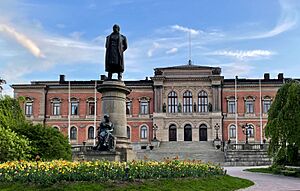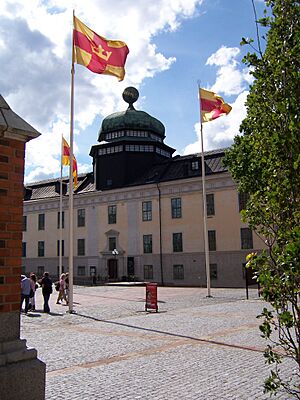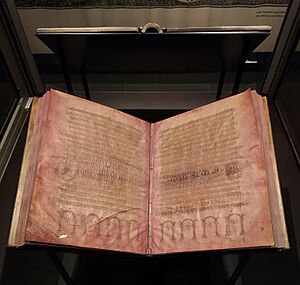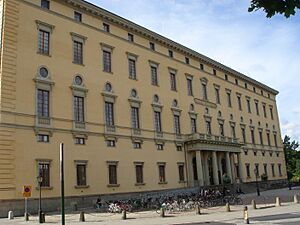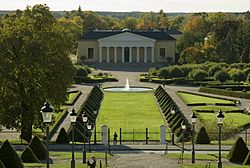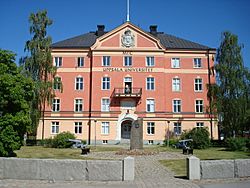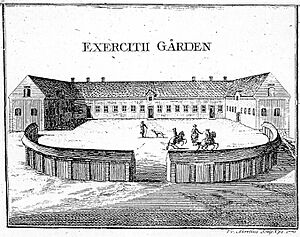Uppsala University facts for kids
|
Uppsala universitet
|
|
 |
|
| Latin: Universitas Regia Upsaliensis | |
| Motto | Gratiae veritas naturae (Latin) |
|---|---|
|
Motto in English
|
Truth through the grace of God and through nature |
| Type | Public research university |
| Established | 1477 |
| Budget | SEK 7.398 billion |
| Rector magnificus | Anders Hagfeldt |
|
Academic staff
|
4,135 FTE |
|
Administrative staff
|
2,150 FTE |
| Students | 52,241 (28,289 FTE) |
| 2,228 | |
| Location | , |
| Campus | Urban / University town |
| Colours | Maroon, white |
| Affiliations | Coimbra Group EUA Matariki Network of Universities Guild of European Research-Intensive Universities |
Uppsala University (often called UU) is a public research university in Uppsala, Sweden. It was started in 1477, making it the oldest university in Sweden and in the Nordic countries that is still open today.
The university became very important when Sweden grew into a powerful country in the late 1500s. It received a big gift of money and land from King Gustavus Adolphus in the early 1600s, which helped it become financially stable. Uppsala University has played a huge role in Swedish culture, history, and national identity. Many Swedish academic traditions, like the white student cap, began here. It also shares unique features, such as the student nation system, with Lund University and the University of Helsinki.
Uppsala University is part of the Coimbra Group of European universities and the Guild of European Research-Intensive Universities. It is often ranked among the top 100 universities in the world.
The university has nine main study areas, called faculties. These are grouped into three larger fields: Humanities and Social Sciences, Medicine and Pharmacy, and Science and Technology. In 2020, about 52,000 students were studying there, including 2,200 PhD students.
Many of Uppsala University's historic buildings are located in the Fjärdingen area, near Uppsala Cathedral. Even with new buildings, the university's presence still defines the historic center of Uppsala.
Contents
History of Uppsala University
How Uppsala University Started
Like most universities in the Middle Ages, Uppsala University began near a church center. The archbishop of Uppsala was a very important religious leader in Sweden. Uppsala was also a busy trading town for a long time.
The university officially started with a special paper from Pope Sixtus IV in 1477. This paper gave the university the same rights and freedoms as the famous University of Bologna in Italy. This meant it could have four main study areas: theology (religion), law, medicine, and philosophy. Students could earn different degrees, like bachelor's and master's. The Archbishop of Uppsala was made the university's leader, called the Chancellor.
Changes in the 1500s
The 1500s were a difficult time because of the Reformation, a big religious change led by King Gustavus Vasa. Uppsala was seen as a Catholic center, so fewer students attended. Many Swedish students went to Protestant universities in Germany instead.
However, academic studies continued. King Eric XIV and his brother John III appointed professors. By the end of the century, Uppsala became a strong center for Lutheranism. In 1593, the Uppsala Synod made Lutheranism the official religion in Sweden. King Charles IX then gave new rights to the university.
Theology was still important, but the university also focused on training people for the government. Seven professor positions were created, including ones for astronomy, physics, and Latin. By 1599, there were about 150 students. In 1600, the first graduation ceremony after the Reformation took place. The university's official seal, still used today, was designed in the same year.
Growth in the 1600s
In the Middle Ages, Uppsala was mainly a theology school. But as Sweden became a powerful country, it needed different kinds of learning. The country was growing and changing its government, so it needed more trained officials and teachers. New schools, called gymnasiums, were also started. Other universities were founded in different parts of the Swedish Empire, like in Estonia and Finland.
A key person in these changes was Axel Oxenstierna, who was the university's chancellor. Gustavus Adolphus was very interested in the university. He increased the number of professors and, in 1624, he gave the university all his personal land and income from two provinces. This gift provided a stable income for the university forever.
The university got a clear structure with its rules in 1626. The chancellor was the main leader, and the Archbishop of Uppsala was the deputy. The daily running of the university was handled by the consistory, which included all professors, and the rector magnificus, who was elected for a short time.
In the early 1600s, the university was in an old building called Academia Carolina. A new building, Gustavianum, was built between 1622 and 1625. By the 1630s, about 1,000 students attended the university.
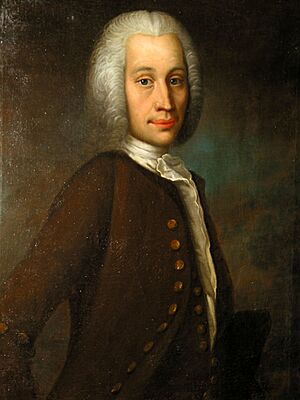
Queen Christina was also very generous. She gave money for Swedish students to study abroad and invited foreign scholars to teach in Uppsala. One of them was Johannes Schefferus, whose library is now part of the Royal Society of Sciences in Uppsala.
A young doctor named Olaus Rudbeck was very important in the mid-1600s. He studied in the Netherlands and then worked to improve the university. He started the first botanical garden, which was later cared for by Carl Linnaeus and is now a museum called Linnéträdgården. Rudbeck became a full professor in 1660 and was elected rector several times. He also designed and built the anatomical theater on top of Gustavianum, which is famous for its dome.
In 1702, a large fire destroyed much of Uppsala. Gustavianum, with the university library and its valuable books, was saved. People say that the elderly Rudbeck helped direct the firefighting efforts from the roof.
The 1700s: New Ideas and Practical Knowledge
The early 1700s still focused on religion and classical studies. But soon, there was a greater interest in science and practical knowledge. Important scientists like mathematician Samuel Klingenstierna (professor in 1728), physicist Anders Celsius (professor in 1729), and botanist Carl Linnaeus (professor in 1741) joined the university.
The government at the time wanted to promote science. In 1741, they created a professorship in economics, the first outside Germany. This showed a new focus on how science could help the economy.
University studies became more organized. Before, many students didn't graduate because there wasn't a specific degree for their chosen job. New professional degrees were introduced in 1749–1750.
After the 1702 fire, Uppsala Cathedral and Uppsala Castle were rebuilt by Carl Hårleman, a famous Swedish architect. He also updated Gustavianum and built a new building for the university's administration.
Another big gift came from Gustav III, who gave the university the large baroque garden of the castle. This new garden was much bigger than the old botanical garden. The old garden, where Rudbeck and Linnaeus worked, was later rebuilt to look like it did in Linnaeus's time.

Women at Uppsala University
The idea of women studying at universities was first discussed in 1865. At first, many people, especially from the clergy, were against it. But in 1870, it was decided that women could take the "studentexamen," a test that allowed them to enter universities. They could then study medicine in Uppsala and Lund. People thought women's caring nature would make them good doctors, but they could only work in private practice.
In 1873, women's rights to higher education expanded. They could study for almost all degrees, except in theology and some law degrees.
The first female student in Sweden was Betty Pettersson (1838–1885). She entered Uppsala University in 1872 and was the first woman in Sweden to earn an academic degree in 1875. She then became the first woman to teach in a public school for boys.
Ellen Fries (1855–1900) was the first woman in Sweden to earn a doctoral degree. She started at Uppsala in 1877 and got her PhD in history in 1883.
Lydia Wahlström (1869–1954) was another important female student. She became a well-known teacher, activist, and writer who fought for women's rights. In 1900, she became the second woman to earn a doctorate at a Swedish university. In 1892, she started the Uppsala Women's Student Association. Its members were the first women to wear student caps in public, which was an important symbol of their status.
Elsa Eschelsson (1861–1911) was the first Swedish woman to earn a law degree and the first to become a "docent" (a high academic position). However, she was not allowed to be a professor because she was a woman, even though she was qualified.
For a long time, only "native Swedish men" could be professors. This rule changed in 1925. The first woman to become a professor at Uppsala University was Gerd Enequist, who was appointed in 1949.
Hildegard Björck also studied at the university and became the first Swedish woman to receive an academic degree.
How Uppsala University is Organized
Main Leadership
The university is run by a board called the consistory. It includes professors, students, and non-academic staff. There are also ten members from outside the university chosen by the Swedish government. All these members can vote.
Unions at the university also have representatives on the board. They can speak but not vote.
The main leader of the university is the rector magnificus, who has a deputy called the prorector. There are also three vice rectors, each in charge of one of the three main study areas. Each faculty has its own board and is led by a dean, who is a professor from that faculty.
Study Areas (Faculties)
Uppsala University has nine faculties, which are like different schools within the university. They are grouped into three main areas:
Arts and Social Sciences
- Faculty of Arts
- Faculty of Social Sciences
- Faculty of Languages
- Faculty of Theology
- Faculty of Law: This is the oldest law faculty in the Nordic countries. It existed even before the university officially started in 1477.
- Faculty of Educational Sciences (became a faculty in 2002)
Medicine and Pharmacy
- Faculty of Medicine
- Faculty of Pharmacy: This used to be a separate school in Stockholm but joined Uppsala University between 1968 and 1972.
Science and Technology
- Faculty of Science and Technology: The engineering programs here were once called the Uppsala School of Engineering, but it's always been part of this faculty.
University Library
The university library is huge! It has about 5.25 million books and magazines, over 60,000 old manuscripts, and many maps and music prints. One of its most famous treasures is the Codex Argenteus, an ancient Bible manuscript written in Gothic.
The main library building is called Carolina Rediviva. Its name means "revived Carolina" because it replaced an older library building. The library was once in Gustavianum and amazingly survived the big city fire of 1702. The current Carolina Rediviva building was completed in 1841.
Today, the university library system has 19 different branches, including the main Carolina building.
Uppsala University Hospital
The Uppsala Academic Hospital, or Akademiska sjukhuset, is a teaching hospital. This means it's where medical students from the university learn and practice. It works closely with the university's Faculty of Medicine. In 2003, the hospital had over 7,700 employees and more than 1,000 patient beds.
The hospital is actually older than the university itself! It started as a hospital in Uppsala in 1302. The first clinic specifically for teaching medical students was founded in 1708. The current Akademiska sjukhuset was formed in 1850 by combining the county hospital and the university clinic. Its main building opened in 1867 and has grown into the large hospital complex you see today.
The Svedberg Laboratory
The Svedberg Laboratory is a special university facility. It has a machine called the Gustaf Werner cyclotron. This machine is used for research and also for proton therapy, a special type of cancer treatment. This makes Uppsala University Hospital one of only about 40 places in the world that can offer this advanced cancer treatment.
Special Lecture Series
Philosophy Department Lectures
Hägerström Lectures
The Hägerström Lectures are a series of talks given each year by famous philosophers. They are hosted by the Department of Philosophy at Uppsala University.
These lectures started in 1971, thanks to Professor Stig Kanger. The idea was to invite a well-known philosopher to give a few talks on a single topic and meet with students and teachers. The series is named after Axel Hägerström, a former professor who founded the Uppsala School of ethics.
Many important philosophers have given these lectures, including Julia Annas, Donald Davidson, Ian Hacking, Christine Korsgaard, Saul Kripke, Martha Nussbaum, Hilary Putnam, Willard Van Orman Quine, and Amartya Sen.
University Campus
University Park and Cathedral Area
This area has many historic university buildings:
- Gustavianum
- Old Consistory building
- University Hall
- Ekerman House
- The Dean's House
- Skytteanum
- Oxenstierna House (now the Faculty of Law)
- Regnellianum
- Carolina Rediviva (the main library)
West of Central Uppsala
- English Park Campus – Centre for the Humanities (including language studies)
- Centre for Evolutionary Biology (EBC), which includes the Museum of Evolution
- Botanical Garden
- Segerstedt Building – the main administrative building
- Blåsenhus – a center for education and psychology
Other Locations in Central Uppsala
- Theatrum Oeconomicum and Gamla Torget ("The Old Forum")
- The Observatory Park with the old observatory
- Ekonomikum
- The Linnaeus Garden
- Anders Celsius's former house and observatory
South of Central Uppsala
- Uppsala University Hospital
- The Rudbeck Laboratory
- Uppsala Biomedical Centre (BMC)
- Geocentrum
- Information Technology Centre (ITC)
- Ångström Laboratory
- Epidemiology hub (Epihubben)
Outside of Uppsala
- Campus Gotland (on the island of Gotland)
Student Life
Nations and Student Unions
Until June 2010, students at Uppsala University had to join one of the nations. These are student groups traditionally based on where students came from in Sweden. This system started around the 1630s. In Sweden, nations only exist in Uppsala and Lund. Each nation is overseen by a professor.
There are currently thirteen nations, all with a history going back to the 1600s. Some of them are combinations of older, smaller nations.
The nations at Uppsala University are:
|
|
|
The Uppsala Student Union was founded in 1849 to represent all students. The Pharmaceutical Student Union also became a student union when the Faculty of Pharmacy joined the university.
Compulsory membership in a student union ended on July 1, 2010. However, the unions still represent students on university boards. As of July 2013, there were four student unions, and by February 2016, two more were added. Now, there are six student unions at Uppsala University, each representing students from different faculties or study areas.
Music at the University
The university's Royal Academic Orchestra was started in 1627. It mainly plays at university ceremonies but also holds concerts. Famous composers like Wilhelm Stenhammar and Hugo Alfvén have led it.
Uppsala University also has three choirs: the mixed Uppsala University Choir, the male choir Orphei Drängar, and the Academy Chamber Choir of Uppsala. Many other choirs and orchestras are connected to the student nations.
A very important person in the history of these choirs is Eric Ericson, who conducted both Orphei Drängar and the Chamber Choir. In his honor, the Eric Ericson Chair in Choral Directing was created, and the Uppsala University Choral Centre opened in 2000. This center offers courses in conducting choirs.
Finding Housing
Like many cities, Uppsala has a shortage of housing, which has been a problem for many years. Both Swedish and international students can find it hard to find a place to live when they first arrive. However, this problem has improved since 2010 with new housing projects.
In Sweden, universities usually don't provide housing for students. Students are expected to find their own places. To help, the student nations and unions have built special student rooms and apartments that are more affordable. But there aren't enough student homes for everyone. About 40,000 students are eligible for only 11,000 rooms and apartments. Because the rent is low, these places are very popular, and many students try to keep them even after they graduate.
Some popular student housing areas include Flogsta, Kantorsgatan, Studentstaden, Studentvägen, Klostergatan, and Rackarbergsgatan. Flogsta is especially popular with international students.
Sports and Activities
Compared to universities in the UK or USA, sports play a smaller role at Uppsala University. However, sports have been part of university life since the 1600s. Uppsala University is more famous for its music and choir traditions.
The Exercitiae
In the 1630s, the university started offering special training called exercitiae (exercises). These were skills considered important for young noblemen, such as riding, fencing, dance, drawing, and modern languages like French and Italian. This idea came from Chancellor Axel Oxenstierna, who wanted to ensure that noble students were well-educated. An "exercise yard" was built for riding and fencing. Modern languages later became part of the regular studies.
The surviving "exercises" today include:
- Fencing: Done with a private fencing club.
- Gymnastics and sports: Held at the University Gymnastics Hall, nicknamed Svettis (meaning "sweaty place" in Swedish).
- Riding: The university has its own stables and riding activities.
- Music: Led by the director musices, who conducts the Royal Academic Orchestra.
- Drawing: The university hires a professional artist as a Drawing Master, offering free lessons at Uppsala Castle.
Other Sports
Other sports have also been part of student life. The Upsala Simsällskap, the oldest swimming club in the world, was founded in 1796 by mathematician Jöns Svanberg. Although not formally part of the university, its first members were academics. Svanberg even created a fun "swimming graduation" ceremony, where swimmers earned "master" and "bachelor" degrees. These terms are still used in Swedish swimming schools today!
In the 1870s, there was an attempt to start academic rowing, similar to universities in England. The Stockholms nation and Göteborgs nation got rowing boats, and they held competitions. While rowing never became as big as in England, an annual regatta (boat race) between Uppsala and Lund University has been held since 1992. The race takes place on the Fyris River in Uppsala every even year and near Lund every odd year.
University Rankings
| University rankings | |
|---|---|
| Global – Overall | |
| ARWU World | 88 (2024) |
| QS World | 93 (2026) |
| THE World | 130 (2025) |
Overall Rankings
Uppsala University is one of the top universities in Sweden and is often ranked among the world's best. For example, for over ten years, it has been in the top 80 universities globally by the Academic Ranking of World Universities.
Times Higher Education ranked Uppsala among the top 101–125 most respected universities worldwide in 2023. It was also ranked the 68th most international university in the world in 2023.
Rankings by Subject
| Subject | Uppsala's world rank |
|---|---|
| Pharmacy & Pharmacology | 24 |
| Biological Sciences | 52 |
| Life Sciences & Medicine | 77 |
| Environmental Sciences | 80 |
| Chemistry | 83 |
| Sociology | 91 |
| Geography | 51–100 |
| Politics | 51–100 |
| Nursing | 51–100 |
| Archeology | 51–100 |
| Development Studies | 51–100 |
| History | 51–100 |
| Theology, Divinity, and Religious Studies | 51–100 |
| Broad Subject Area | Uppsala's world rank |
|---|---|
| Life Sciences & Medicine | 77 |
| Natural Sciences | 120 |
| Arts and Humanities | 151 |
| Social Sciences & Management | 216 |
| Engineering & Technology | 237 |
| Subject | Uppsala's world rank |
|---|---|
| Life Sciences | 52 |
| Social Sciences | 101–125 |
| Arts & Humanities | 101–125 |
| Physical Sciences | 126–150 |
| Clinical, Pre-clinical & Health | 126–150 |
| Business and Economics | 251–300 |
| Engineering & Technology | 301–400 |
Famous People from Uppsala University
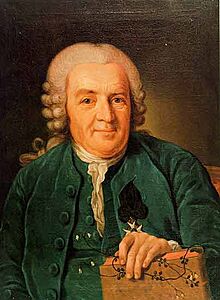

Uppsala University has been home to many famous people, including 8 Nobel Prize winners, members of royalty, and important figures in academics and public life.
For centuries, Uppsala University was the main place for learning in Sweden. Many Swedish politicians and government officials studied here. This includes people like Hjalmar Branting (1860–1925), who became Sweden's first Social Democratic Prime Minister.
Other famous alumni include Dag Hammarskjöld (1905–1961), who was the Secretary-General of the United Nations and won the Nobel Peace Prize after he passed away. Hans Blix (born 1928), a Swedish diplomat, also studied here. He led important international organizations like the International Atomic Energy Agency. Both Hammarskjöld and Blix studied law at Uppsala.
Most Swedish clergy, including bishops and archbishops, have studied at Uppsala. This includes Nathan Söderblom (1866–1931), a professor who later became the Archbishop of Uppsala and won the Nobel Peace Prize for his work in uniting different Christian churches.
The university became well-known for science in the 1700s. Key figures include:
- Carl Linnaeus (1707–1778), a doctor and botanist known as the "father of taxonomy" for his system of naming plants and animals. Many of his important students also became famous.
- Anders Celsius (1701–1744), a physicist and astronomer who invented the Celsius temperature scale.
- Torbern Bergman (1735–1784), a chemist.
Another scientist from this time was Emanuel Swedenborg (1688–1772), who is now better known as a religious mystic. Uppsala scientists also discovered several chemical elements. Jöns Jakob Berzelius, one of the founders of modern chemistry, earned his doctorate in medicine at Uppsala in 1804. In the 1800s, physicist Anders Jonas Ångström (1814–1874) was also from Uppsala. In the 1900s, several Nobel laureates in science were either alumni or professors at Uppsala University.
Many well-known Swedish writers have studied in Uppsala:
- Georg Stiernhielm (1598–1672) is often called the father of Swedish poetry.
- Carl Michael Bellman (1740–1795), a beloved poet and songwriter, attended for less than a year.
- Erik Gustaf Geijer (1783–1847), a writer, historian, and professor of history, was a key figure in early 1800s Swedish romanticism.
- August Strindberg (1849–1912), a famous novelist and playwright, wrote stories about his experiences as a student in Uppsala.
- Erik Axel Karlfeldt (1864–1931), a poet who won the Nobel Prize for Literature after he passed away.
- Pär Lagerkvist (1891–1974), a novelist and playwright who won the Nobel Prize for Literature in 1951.
- Karin Boye (1900–1941), a poet and novelist, has a university library branch named after her.
Working with Other Universities
Uppsala University has student exchange agreements with about 400 universities around the world. It participates in the Erasmus programme and the Nordplus programme, which allow students to study abroad. It also benefits from being a member of the Coimbra Group of universities.
In May 2010, Uppsala joined the Matariki Network of Universities (MNU). This network includes universities from different countries like Dartmouth College (USA), Durham University (UK), Queen's University (Canada), University of Otago (New Zealand), University of Tübingen (Germany), and University of Western Australia (Australia).
See also
 In Spanish: Universidad de Upsala para niños
In Spanish: Universidad de Upsala para niños
- List of medieval universities
- List of universities in Sweden
- Swedish University of Agricultural Sciences in Uppsala
- Johannelunds Teologiska Högskola in Uppsala
- Flogsta – a student residential area in Uppsala
- Category:Uppsala University alumni
- S*, a collaboration between seven universities and the Karolinska Institutet for training in bioinformatics and genomics


